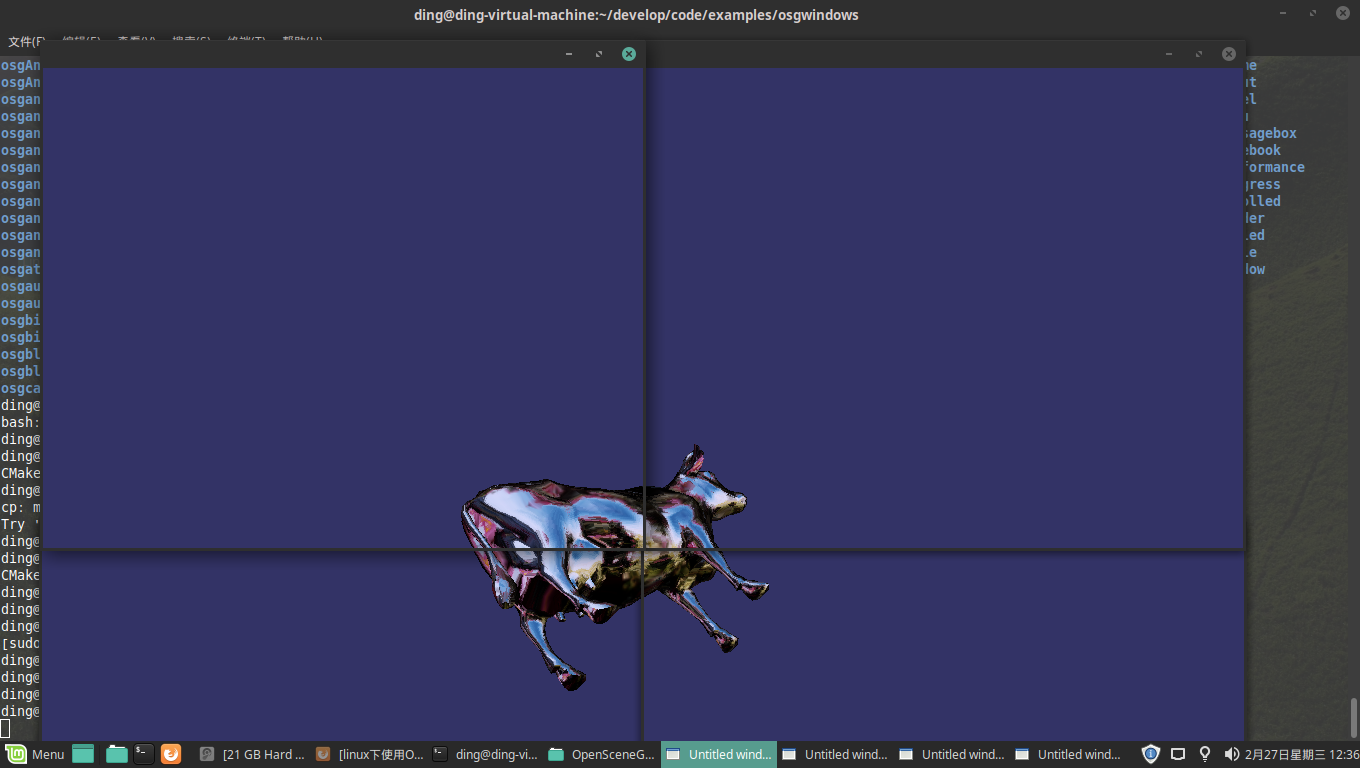Learning OSG programing---osgwindows
/* OpenSceneGraph example, osgwindows.
*
* Permission is hereby granted, free of charge, to any person obtaining a copy
* of this software and associated documentation files (the "Software"), to deal
* in the Software without restriction, including without limitation the rights
* to use, copy, modify, merge, publish, distribute, sublicense, and/or sell
* copies of the Software, and to permit persons to whom the Software is
* furnished to do so, subject to the following conditions:
*
* THE SOFTWARE IS PROVIDED "AS IS", WITHOUT WARRANTY OF ANY KIND, EXPRESS OR
* IMPLIED, INCLUDING BUT NOT LIMITED TO THE WARRANTIES OF MERCHANTABILITY,
* FITNESS FOR A PARTICULAR PURPOSE AND NONINFRINGEMENT. IN NO EVENT SHALL THE
* AUTHORS OR COPYRIGHT HOLDERS BE LIABLE FOR ANY CLAIM, DAMAGES OR OTHER
* LIABILITY, WHETHER IN AN ACTION OF CONTRACT, TORT OR OTHERWISE, ARISING FROM,
* OUT OF OR IN CONNECTION WITH THE SOFTWARE OR THE USE OR OTHER DEALINGS IN
* THE SOFTWARE.
*/ #include <osgDB/ReadFile>
#include <osgUtil/Optimizer>
#include <osgViewer/Viewer> #include <iostream> int main( int argc, char **argv )
{
// use an ArgumentParser object to manage the program arguments.
osg::ArgumentParser arguments(&argc,argv); // read the scene from the list of file specified commandline args.
osg::ref_ptr<osg::Node> loadedModel = osgDB::readRefNodeFiles(arguments); // if not loaded assume no arguments passed in, try use default mode instead.
if (!loadedModel) loadedModel = osgDB::readRefNodeFile("/home/ding/Downloads/OpenSceneGraph-Data/cow.osgt");
//this path was modified because the OSG_FILE_PATH is not configed correctly in my computer!
//so it is an alternative method // if no model has been successfully loaded report failure.
if (!loadedModel)
{
std::cout << arguments.getApplicationName() <<": No data loaded" << std::endl;
return ;
} // construct the viewer.
osgViewer::Viewer viewer; int xoffset = ;
int yoffset = ; // left window + left slave camera
{
osg::ref_ptr<osg::GraphicsContext::Traits> traits = new osg::GraphicsContext::Traits; traits->x = xoffset + ;
traits->y = yoffset + ;
traits->width = ;
traits->height = ;
traits->windowDecoration = true;
traits->doubleBuffer = true;
traits->sharedContext = ;
traits->readDISPLAY();
traits->setUndefinedScreenDetailsToDefaultScreen(); osg::ref_ptr<osg::GraphicsContext> gc = osg::GraphicsContext::createGraphicsContext(traits.get()); osg::ref_ptr<osg::Camera> camera = new osg::Camera;
camera->setGraphicsContext(gc.get());
camera->setViewport(new osg::Viewport(,, traits->width, traits->height));
GLenum buffer = traits->doubleBuffer ? GL_BACK : GL_FRONT;
camera->setDrawBuffer(buffer);
camera->setReadBuffer(buffer); // add this slave camera to the viewer, with a shift left of the projection matrix
viewer.addSlave(camera.get(), osg::Matrixd::translate(1.0,-1.0,0.0), osg::Matrixd());
} // right window + right slave camera
{
osg::ref_ptr<osg::GraphicsContext::Traits> traits = new osg::GraphicsContext::Traits;
traits->x = xoffset + ;
traits->y = yoffset + ;
traits->width = ;
traits->height = ;
traits->windowDecoration = true;
traits->doubleBuffer = true;
traits->sharedContext = ;
traits->readDISPLAY();
traits->setUndefinedScreenDetailsToDefaultScreen(); osg::ref_ptr<osg::GraphicsContext> gc = osg::GraphicsContext::createGraphicsContext(traits.get()); osg::ref_ptr<osg::Camera> camera = new osg::Camera;
camera->setGraphicsContext(gc.get());
camera->setViewport(new osg::Viewport(,, traits->width, traits->height));
GLenum buffer = traits->doubleBuffer ? GL_BACK : GL_FRONT;
camera->setDrawBuffer(buffer);
camera->setReadBuffer(buffer); // add this slave camera to the viewer, with a shift right of the projection matrix
viewer.addSlave(camera.get(), osg::Matrixd::translate(-1.0,-1.0,0.0), osg::Matrixd());
} // left_down window + right slave camera
{
osg::ref_ptr<osg::GraphicsContext::Traits> traits = new osg::GraphicsContext::Traits;
traits->x = xoffset + ;
traits->y = yoffset + ;
traits->width = ;
traits->height = ;
traits->windowDecoration = true;
traits->doubleBuffer = true;
traits->sharedContext = ;
traits->readDISPLAY();
traits->setUndefinedScreenDetailsToDefaultScreen(); osg::ref_ptr<osg::GraphicsContext> gc = osg::GraphicsContext::createGraphicsContext(traits.get()); osg::ref_ptr<osg::Camera> camera = new osg::Camera;
camera->setGraphicsContext(gc.get());
camera->setViewport(new osg::Viewport(,, traits->width, traits->height));
GLenum buffer = traits->doubleBuffer ? GL_BACK : GL_FRONT;
camera->setDrawBuffer(buffer);
camera->setReadBuffer(buffer); // add this slave camera to the viewer, with a shift right of the projection matrix
viewer.addSlave(camera.get(), osg::Matrixd::translate(1.0,1.0,0.0), osg::Matrixd());
} // right_down window + right slave camera
{
osg::ref_ptr<osg::GraphicsContext::Traits> traits = new osg::GraphicsContext::Traits;
traits->x = xoffset + ;
traits->y = yoffset + ;
traits->width = ;
traits->height = ;
traits->windowDecoration = true;
traits->doubleBuffer = true;
traits->sharedContext = ;
traits->readDISPLAY();
traits->setUndefinedScreenDetailsToDefaultScreen(); osg::ref_ptr<osg::GraphicsContext> gc = osg::GraphicsContext::createGraphicsContext(traits.get()); osg::ref_ptr<osg::Camera> camera = new osg::Camera;
camera->setGraphicsContext(gc.get());
camera->setViewport(new osg::Viewport(,, traits->width, traits->height));
GLenum buffer = traits->doubleBuffer ? GL_BACK : GL_FRONT;
camera->setDrawBuffer(buffer);
camera->setReadBuffer(buffer); // add this slave camera to the viewer, with a shift right of the projection matrix
viewer.addSlave(camera.get(), osg::Matrixd::translate(-1.0,1.0,0.0), osg::Matrixd());
}
// optimize the scene graph, remove redundant nodes and state etc.
osgUtil::Optimizer optimizer;
optimizer.optimize(loadedModel); // set the scene to render
viewer.setSceneData(loadedModel); return viewer.run();
}
The routine of each slave camera is alike. While the key point is this sentence:
viewer.addSlave(camera.get(), osg::Matrixd::translate(-1.0,1.0,0.0), osg::Matrixd());
This sentence set the viewpoint of slave camera,which translate the position of view point. Four slave camera view the common model in different direction, combine together.
the command to complie this program is following:
g++ -o osgwindows_1 osgwindows_1.cpp -losg -losgDB -losgViewer -lOpenThreads -losgUtil
After compling, just run it with:
sudo ./osgwindows_1
The outcome of above program is shown:

Like moniter constructed with four screen. Drag mouse in one window, the model will rotate in other three screen meanwhile. Great!
Learning OSG programing---osgwindows的更多相关文章
- Learning OSG programing---osgScribe
Learning OSG programing---osgScribe Scribe可以翻译为素描,抄写等.本例通过在模型表面添加一层素描,来显示模型的骨架. 关键代码: osg::ref_ptr&l ...
- Learning OSG programing---Multi Camera in Multi window 在多窗口中创建多相机
这个例子演示了在多个窗口中创建多个相机,函数的代码如下: void multiWindowMultipleCameras(osgViewer::Viewer& viewer,bool mult ...
- Learning OSG programing---Multi Camera in one window 在单窗口中创建多相机
在学习OSG提供的例子osgCamera中,由于例子很长,涉及很多细节,考虑将其分解为几个小例子.本文介绍实现在一个窗口中添加多个相机的功能. 此函数接受一个Viewer引用类型参数,设置图形上下文的 ...
- Learning OSG programing---osgAnimation(3)
接下来是用createModel函数创建模型: osg::ref_ptr<osg::Group> createModel(bool overlay, osgSim::OverlayNode ...
- Learning OSG programing---osgAnimation(2)
osg::Node* createBase(const osg::Vec3& center,float radius) { ; ; *radius; *radius; osg::Vec3 v0 ...
- Learning OSG programing---osgAnimation(1)
osg::AnimationPath* createAnimationPath(const osg::Vec3& center,float radius,double looptime) { ...
- Learning OSG programing---osgShape
本例示范了osg中Shape ---- 基本几何元素的绘制过程.参照osg官方文档,Shape 类包含以下子类: 在示例程序中,函数createShapes函数用于生成需要绘制的几何形状. osg:: ...
- Learning OSG programing---osgClip
OSG Clip例程剖析 首先是创建剪切节点的函数代码: osg::ref_ptr<osg::Node> decorate_with_clip_node(const osg::ref_pt ...
- Coursera Deep Learning 2 Improving Deep Neural Networks: Hyperparameter tuning, Regularization and Optimization - week3, Hyperparameter tuning, Batch Normalization and Programming Frameworks
Tuning process 下图中的需要tune的parameter的先后顺序, 红色>黄色>紫色,其他基本不会tune. 先讲到怎么选hyperparameter, 需要随机选取(sa ...
随机推荐
- Zookeeper——启动闪退
Zookeeper好久不启动了,昨天项目要用Zookeeper了,我昨天突然启动它,调皮的zk居然害羞不让我看见它,启动不了,一启动就闪退,为啥呢?其实是因为报错了,有错zk启动时就会报错,所以昨 ...
- Linux关闭重启系统
reboot:重启系统 - 需要root权限 halt:关机 - 需要root权限 poweroff:关机 - 可直接运行
- elasticsearch 基础 —— Common Terms Query常用术语查询
常用术语查询 该common术语查询是一个现代的替代提高了精确度和搜索结果的召回(采取禁用词进去),在不牺牲性能的禁用词. 问题 查询中的每个术语都有成本.搜索"The brown fox& ...
- css浮动、定位到底什么鬼?
css操作元素位置有以下几种方式:float.position.top等. I float part 1.浮动首先会先将元素在正常文档流中删除,父容器无法获取元素高度,但是该元素依然影响布局. 2.任 ...
- quotaon - 开启关闭文件系统配额
总览 (SYNOPSIS) quotaon [ -e | d ] [ -vug ] filesystem... quotaon [ -e | d ] [ -avug ] quotaoff [ -e | ...
- React(6) --双向数据绑定及列表数据循环
React双向数据绑定:model改变影响view,view改变反过来影响model import React,{Component} from 'react'; class Todolist ext ...
- zabbix入门之监控MySQL
zabbix入门之监控MySQL 这里使用的是zabbix官方自带的MySQL监控模板. 首先确保在被监控主机安装zabbix-agent.zabbix-sender,并且将主机加入监控节点.具体操作 ...
- python常用魔法函数
1.__init__(): 所有类的超类object,有一个默认包含pass的__init__()实现,这个函数会在对象初始化的时候调用,我们可以选择实现,也可以选择不实现,一般建议是实现的,不实现对 ...
- Opacity函数-transparentize()、 fade-out()函数
transparentize() 和 fade-out() 函数所起作用刚好与 opacify() 和 fade-in() 函数相反,让颜色更加的透明.这两个函数会让透明值做减法运算,当计算出来的结果 ...
- [BZOJ3626] [LNOI2014] LCA 离线 树链剖分
题面 考虑到询问的\(l..r,z\)具有可减性,考虑把询问差分掉,拆成\(r,z\)和\(l-1,z\). 显然这些LCA一定在\(z\)到根的路径上.下面的问题就是怎么统计. 考虑不是那么暴力的暴 ...
